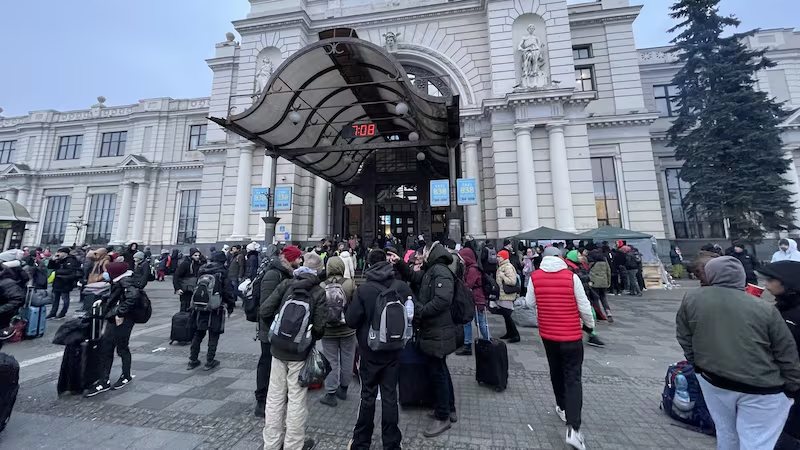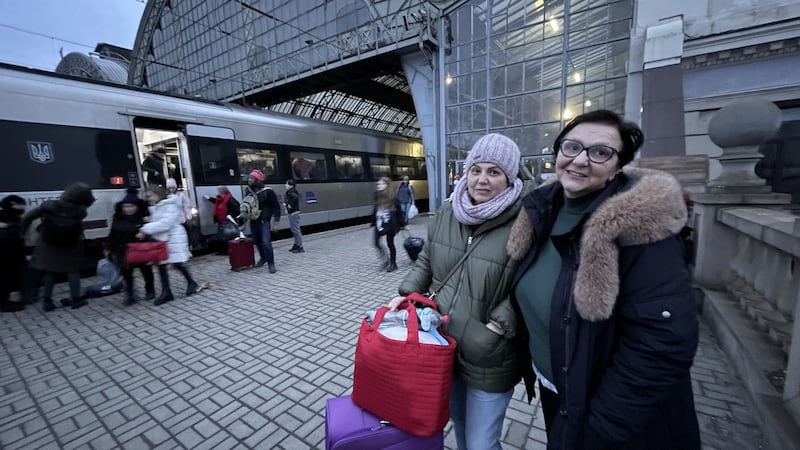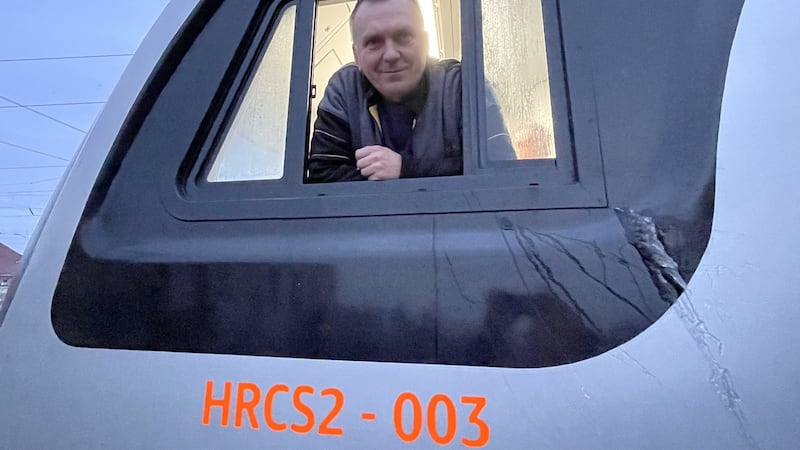Before leaving Kyiv I emptied my fridge and took the food and water to my neighbour, Nina.
The previous night she had hammered harder on my door than I would have thought possible from her slight frame, and ordered me to come down to the second-floor apartment of her friend Tamara, which she thought would be safer than our flats on the fifth.
We had just heard three of the loudest explosions in central Kyiv since Russia invaded Ukraine last Thursday, and while Tamara (81) remained grimly jolly – "You can't cheat fate!" – Nina had been shaken by the blasts and seemed to draw some comfort from our building's three remaining residents being together, even if one of its two cats was still out adventuring in the curfewed city.
I thought she might be upset or angry now that I was going, but the retired doctor reluctantly took the bags of food and said: “I understand. I hope you’ll come back when all this is over.”
Hundreds of thousands of Ukrainians are fleeing Russia’s attack on their homeland from ground, air and sea, many of them on trains that are still plying much of the nation’s network despite the rising danger and threat of panicked chaos at some packed stations.
The only people on Maidan square, the heart of the 2014 revolution that turned Ukraine away from Russia and towards the West, were reporters gathered beside a TV satellite truck and a group of armed men standing in the wet snow.
Camouflage
It took me a moment to realise the man wearing camouflage and a helmet and cradling a Kalashnikov was the same security service officer who, then in plain clothes and carrying a pistol, had checked my passport near here three days before; but he recognised me, gave my bags only a cursory check and waved me on with wishes of good luck.
Even as Russian shelling has drawn closer to the centre of Kyiv, a city of three million people, local authorities have kept the metro running whenever possible.
Trains are irregular and sudden station closures are common, however, with government forces in the capital on high alert for Russian infiltrators and sabotage groups, and an armed guard at the station nearest Maidan told me trains were not stopping there.
“Your best bet is to walk to the central train station,” he said. “You’ve got plenty of time before curfew at 8pm”
As darkness falls the almost-deserted city is an eerie place, where armed men stand in the shadows around strategic buildings, all traffic lights blink orange, and stories of shootouts with Moscow’s operatives make every passing vehicle seem suspicious.
Near the University metro station two cars sit smashed up at the roadside; with so little traffic on the streets a simple accident seems unlikely, and the triangle painted on the bonnet of one wreck resembles a tactical marking that Ukrainian or Russian forces could be using.
Suitcases
Close to the railway station traffic thickens and its thrum mingles with the sound of suitcases being rolled towards what people hope will be escape, either to currently peaceful cities in western Ukraine such as Lviv or Chernivtsi or to one of the four EU states that border Ukraine: Poland, Romania, Hungary and Slovakia.
Most of the station lights are turned off, perhaps to prevent it providing a clear target for Russian bombers, and the gloom is teeming with people trying to find a way out, and dragging children, pets and their belongings with them in desperate search of a train.

The surge when a departure to Warsaw is announced feels like it could become a stampede, and there are screams and cries as parents and children are prised apart, and thoughts of being trapped in Kyiv by the next bombardment race beside fears of losing loved ones and of being hurt in the crush.
On the darkened platforms, some people try to ensure that women, children and the elderly board first, but there are also frantic struggles for places and threats and curses as people defend their spots and bar doors to carriages that are packed way beyond normal capacity.
The regular timetable means nothing, tickets are redundant, the rail operator keeps adding evacuation trains and changing routes as necessary, and station announcements are scant and barely audible – normal rules, in other words, do not apply.
Crammed
After being turned away from two crammed trains made up of Soviet-era carriages in Ukraine’s blue and yellow colours, I notice a gleaming silver intercity idling on a nearby platform that seems to be remarkably calm, orderly and empty.
Noticing the same, a family in front of me clambers down onto the rails, bumps across with their luggage, and clambers up beside the intercity. They appear to board without difficulty, so I follow them across the tracks and see on the train’s digital display that it is going to Lviv, a historic city near the Polish border that the war has not yet reached.
All the seats are taken but I have space to sit on my bag in the vestibule, from where I watch all available space in the carriage and in one of its toilet cubicles fill up with families, pensioners, single men and women, Ukrainian and foreign students and two dogs and a cat.
“This is nothing,” says one man as she shows me footage on his phone of a woman being pushed into a carriage through a window earlier in the day.
Alina Kosse takes a seat on my bag. She is the director of an arts centre and training college in Mariinka, a government-held town on the outskirts of Donetsk, from where she fled when Russian-led separatists seized parts of the Donbas region in 2014.
Fighting is fierce again there now, after Russian president Vladimir Putin recognised the independence of two self-declared militia-run "republics" in Donbas in the days before his full invasion of Ukraine.
“Now this is happening again. I was forced to leave Donetsk, and then to leave Mariinka and now I may have to leave Ukraine,” says Kosse, who is travelling with her sister Marina, who has diabetes.

In normal times, the intercity covers the 500km to Lviv in less than six hours. Tonight it takes 11, giving some people a chance to share their experiences of war coming to a major European country and capital.
Sirens
Iryna, a young woman from Kyiv, says she spent several nights along with thousands of others in metro stations beneath the capital as air-raid alarms wailed above ground.
“I will never get used to those sirens,” she says.
“And I was always worried about saboteurs getting into the station and I kept telling the police about people who I thought looked suspicious. They must have thought I was paranoid. And sleeping was tough, but I managed to get a few hours on the floor of a train that was parked in the station.”
Her mother refused to join the crush that developed to get on this train, and Iryna hopes she will catch one sometime in the early hours of Wednesday, when the city-wide curfew and steady departure of packed trains may thin numbers a little at the station.

Some tempers fray when people try to board the train at stations along our route, and there are thanks to a man in the city of Khmelnytski who passes pies, fruit and water into the carriage.
Children and dogs lie sleeping together on the carriage floor as some adults discuss the first week of war: the fierce resistance shown by Ukraine's forces, the unarmed civilians protesting against Russian tanks entering their towns and villages, and the transformation of President Volodymyr Zelenskiy from ex-comic and failing reformist into inspirational wartime leader.
Explosions
Lviv station is now a busy transit hub for Ukrainians heading for nearby EU states, but beyond that, the city itself is a reminder of what Russia’s invasion has stolen from Kyiv: the bustle of everyday life, streets busy with traffic and pedestrians, open cafes and restaurants and parks where people can linger without listening out for explosions or air-raid sirens.
The new arrivals felt safer now, but many wondered for how long Lviv would remain out of the range of Russia’s guns, and when they would see their beloved capital again.
The man who got them here had no time for such thoughts.
“This journey was smooth, no surprises,” says Ihor, the driver of the train.
“Now I’m heading straight back to Kyiv.”










